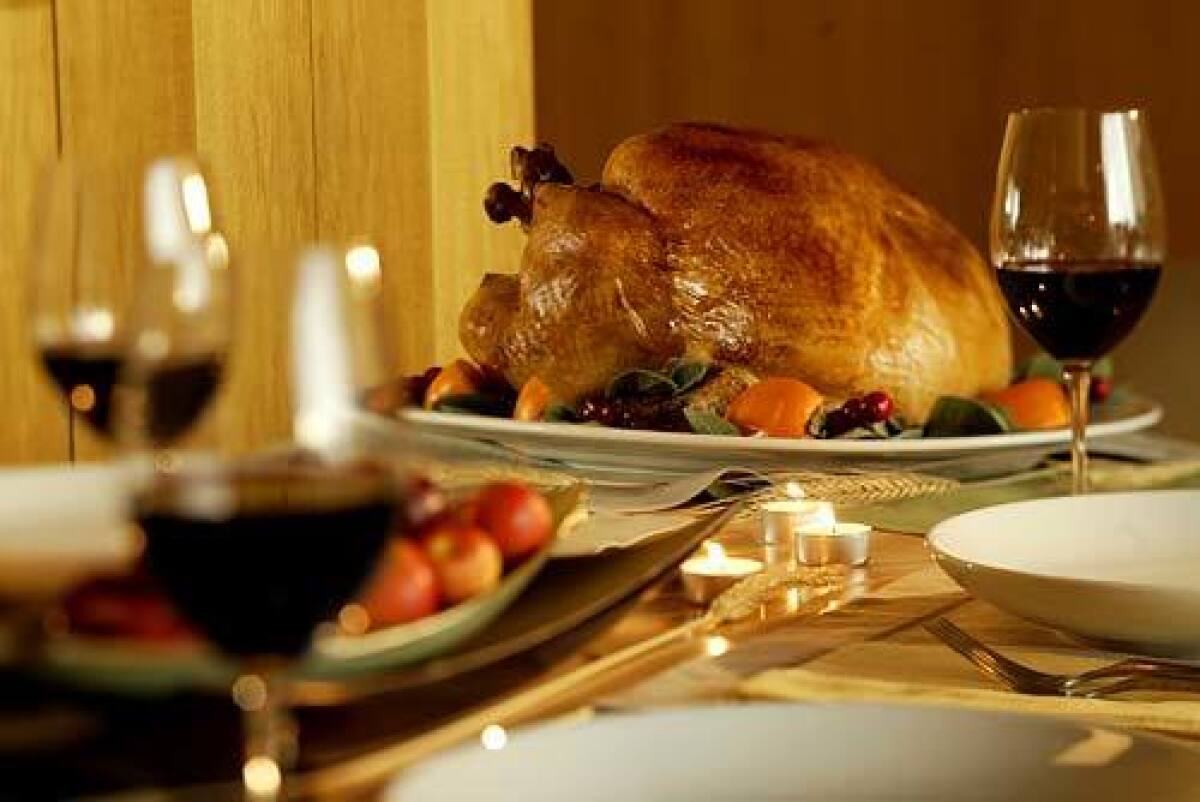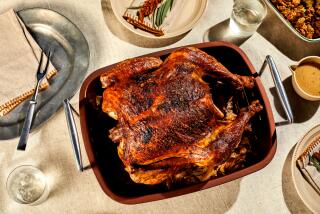Food editor Russ Parsons on the turkey everyone loves

- Share via
After more than 20 years of writing Thanksgiving turkey recipes, I thought I had seen it all. And then came the “Judy Bird.”
Inspired by the chicken-cooking technique of my friend Judy Rodgers, chef and owner at San Francisco’s Zuni Cafe, it couldn’t be simpler: You just salt the turkey a few days in advance, give it a brisk massage every so often to redistribute the salt, and then roast it.
The results are phenomenal. Without the fuss and mess of wet-brining, you still get the deep, well-seasoned flavor. And while wet-brining can sometimes lead to a slightly spongy texture, with dry-brining, the bird stays firm and meaty.
It has become a holiday staple for many of our readers, so we’re reprising it again this year.
Click here for the recipe for dry-brined turkey, a.k.a. ‘the Judy Bird.’
To find out just how well it would work, The Times’ Test Kitchen tested this method two years ago against three other turkey recipes we’d used successfully in the past: steam-roasting (cooking in an old-fashioned covered roaster), high-heat roasting (cooking the bird as you would a chicken, from start to finish at 400 degrees), and the aforementioned wet-brining (soaking the turkey in a saltwater solution for several days before roasting).
I wish everyone who had ever told me that “turkey is turkey” could have been there for the judging. These were remarkably different birds, and the clear winner was the dry-salted Judy Bird.
Video: Food editor Russ Parsons shows you how to carve the turkey.
Our readers clearly agreed. The first week the recipe ran, I received more than 200 e-mails about it, many of them saying it was the best bird they’d ever cooked. Already this holiday season, I’ve gotten more than 30 e-mails from readers who saw the recipe at latimes.com/food. This turkey technique has legs too: Several major food magazines have since done their own versions.
What makes this turkey so great? It’s pretty simple, really: The salt draws moisture from the meat, but then the meat reabsorbs the liquid. So in effect, you’re brining the turkey in its own juices.
There have been some questions about the process.
* No, the turkey is not salty. In the first place, you season it only lightly, about a tablespoon of salt for every 5 pounds of turkey -- that’s only a little more than if you were seasoning it normally. Then the saltiness is further reduced because the seasoning is absorbed through the meat rather than remaining on the surface as it normally would. This is also why you don’t need to rinse or brush the salt from the skin before roasting -- there shouldn’t be any there.
* Yes, you can shorten the salting period. The technique is best if you allow three days for salting and then half a day of air-drying outside the bag in the refrigerator. That half-day is mainly to thoroughly dry the skin so it browns and crisps nicely during roasting. If you’re pressed for time, you can simply pat the skin dry with a towel. If absolutely necessary, you can even shorten the salting period to two days, although the seasoning won’t be quite as effective.
* If you normally stuff your turkey, you can continue to do that, just salt the stuffing a little less than you normally would. (This is a major difference from wet-brining, which does make stuffing too salty.) Be aware, though, that food safety experts recommend cooking stuffing to a temperature of 160 degrees in the center, at which point the breast meat will probably be around 180 degrees and starting to dry out. But if that hasn’t bothered you in the past, this recipe will be no different.
* By the same token, neither are the pan drippings so salty that you can’t make gravy from them. But you will want to add salt just to taste and only at the very end.
* You don’t need to do anything different during the cooking; this technique changes only the seasoning.
* If the turkey isn’t quite as brown as you’d like it, you can return the oven temperature to 450 degrees for the last 20 minutes of roasting for better color. Don’t brown for too long or the breast meat will dry out.
* You can adapt this technique to a turkey breast, using the same proportion of salt to weight and roasting the breast as you normally would.
* The one issue still unresolved is whether you can use this technique if you’re starting with a frozen bird. Theoretically, the answer is yes. But since we still haven’t tried that variation in the Test Kitchen, our recommendation is to start with a fresh turkey.
Parsons is a Times staff writer.



